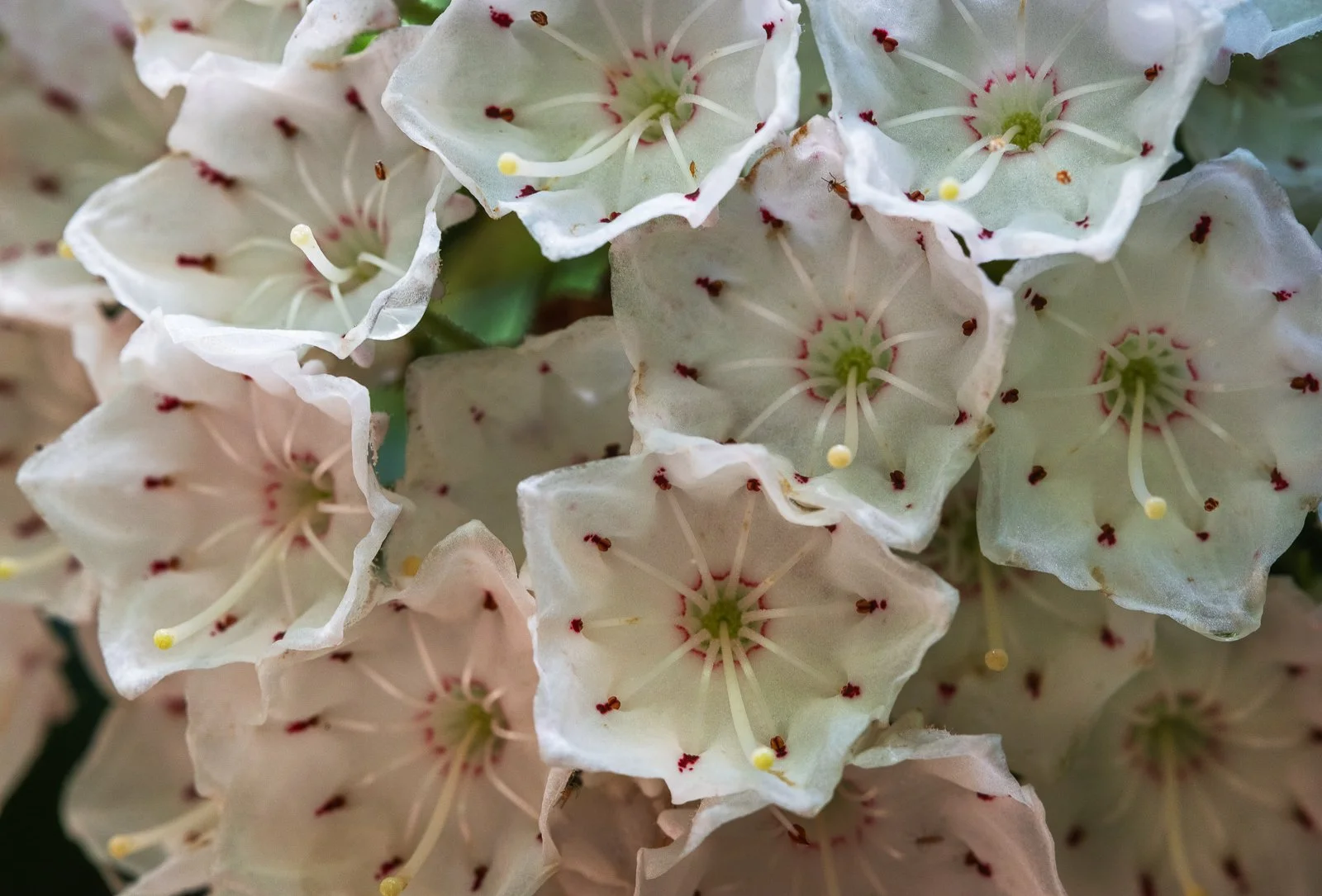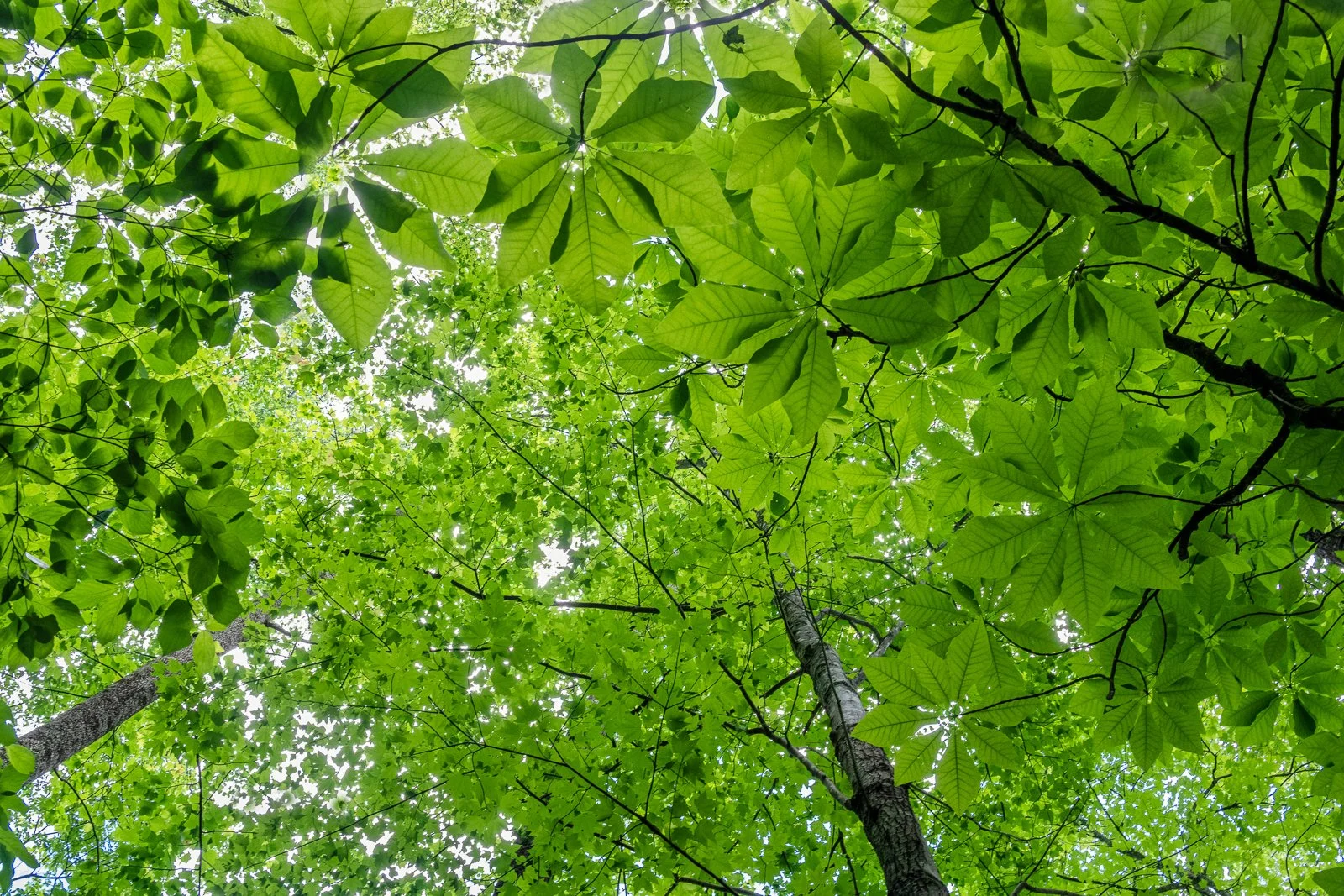Appreciating Mountain Laurel, Beautiful Vistas and the Hard Work of Volunteers and Staff from Conserving Carolina for All Their Hard Work in Re-opening Youngs Mountain Trail Near Lake Lure
Clouds Over Hickory Nut Gorge, View From Youngs Mountain
Conserving Carolina began pursuing protecting the land on Youngs Mountain in 2007, and facilitated the purchase of 96 acres from landowner Tommy Hartzog in 2013, the purchase of 300 acres from Tim Sweeney in 2017, and 19 more acres acquired from Hartzog in 2017, the same year the land trust formally purchased the land. The trail was not built until 2020 and opened to the public in April 2021. The trail was closed to the public in 2024 following Hurricane Helene, because of fallen trees, a landslide, a damaged stream crossing, and holes from torn-out root balls. Conserving Carolina’s volunteers known as Rock Crushers spent months cleaning up the trail and making it safe for the public, and it reopened again in February. I had not hiked this 4.2 out and back trail yet and was so impressed by the natural beauty along the trail and the views from the rocky outcroppings. It was particularly impressive the day we went, since gorgeous clouds filled the sky until the rain came at the end of our hike. Besides the spectacular views, the area is also home to lots of biodiversity, including rare mosses and lichens, wildflowers (apparently there are lots of bloodroot that bloom in March and April) native azaleas and the mountain laurel that was in full bloom. David Lee, Conserving Carolina’s natural resources manager, had this to say about Youngs Mountain: “This project beautifully combines conservation and sustainable recreation. Critical habitat for over 380 plant and animal species, including 25 rare species, is now permanently protected. All the while, the Youngs Mountain Trail expertly winds its way through spectacular hardwood forests and low elevation glade communities before terminating atop a granitic dome. This trail really shows off some of the best that North Carolina has to offer.“ Below are some more views of the surrounding area from the mountain.
View from Youngs Mountain
The trail is accessed through private property, so you will need to get a parking pass and directions from Conserving Carolina here: https://conservingcarolina.org/youngs-mountain/. They consider it to be the crown jewel of the Hickory Nut Gorge State Trail network that is being developed and will link Lake Lure, Chimney Rock, Florence Nature Preserve, Wildcat Rock, and Bearwallow Mountain with Youngs Mountain and Buffalo Creek Park. The 437 acres are forever-protected land and indeed offer some of the best views I’ve seen in the area and the biodiversity I witnessed is phenomenal.
Mountain Laurel Explosion, Youngs Mountain
The mountain laurel were in full bloom and so beautiful. Like rhododendron, they have shallow roots systems that spread horizontally and hold the soil in place. They grow in thickets, which help stabilize mountain slopes and riverbanks and help prevent erosion. Though they can survive even when the air is polluted, they do better in environments where there is good air movement. The steep cliffs and valleys of the gorge contribute to good air circulation, which is beneficial for the roots of these shrubs by preventing the buildup of excess moisture.
Mountain Laurel Along the Trail
Jewels in Indra’s Net
Though I love rhododendrons and often refer to them as the mangroves of the Appalachians, there is something about mountain laurel that always touches me deeply. They have such delicate flowers and are tinged with deep red on the inside of their snow-white flowers. They grow in rocky, often challenging environments, and are considered symbolic of perseverance, resilience, and enduring beauty. To me all lifeforms are jewels in Indra’s Net, each reflecting the beauty of all other lifeforms that exist in our interdependent, interconnected universe. The mountain laurel are perfect illustrations of this concept, and I am always filled with joy when they light up our mountain slopes making them look like a magical fairyland.
Lichen and Vegetation, a Resurgence of Vitality
The National Academy of Sciences has identified the Blue Ridge Mountains as the top priority in the country for conservation of biodiversity. As I looked at the lichen-covered rocks and cliffs and the grasses and plants growing among them, I could see how rich this area is and was more thankful than ever to Conserving Carolina for the work they do. Walking in such wild areas is so good for my mental health, because I am able to witness the vitality of life when ecosystems are allowed to function naturally in symbiotic and helpful ways.
I’m always so amazed when trees manage to keep growing right on top of boulders, even as more and more soil is washed away. Yet, I know that they do not do it alone, just as we cannot survive without the support of other people, the natural environment, and the elements, despite western man’s frequent hubris and the myth of the self-made man. The more we learn, the more we understand how trees help each other, and how fungi and algae and other microscopic lifeforms contribute to shared energy and nutrients. Just yesterday, I was listening to a talk by Catherine Keller presented by Open Horizons, a group dedicated to exploring a process world view and way of living. She mentioned how neighboring trees have been known to nourish nearby tree stumps for decades keeping them alive so that they could keep sharing their valuable DNA. Would that humans in the western world understood the importance of supporting nature and the aging and dying, both human and more than human beings.
Though the streams we crossed on Youngs Mountain looked calm now, they must have been raging during Helene. Trees were toppled everywhere along their banks. Yet, the water was still clean and the plentiful ferns and plants that have sprung up made me hopeful that nature will come back from Helene, that is until the next bad storm hits and they do seem to be becoming more frequent and stronger.
The images above give some indication of the amount of devastation that Conserving Carolyn had to help clear off the trails before the area re-opened. Even though this and so many locationss in Western North Carolina have suffered so much destruction, beauty and biodiversity still remain, which makes protecting places such as Youngs Mountain more important than ever–especially since areas under Federal control may soon be opened for logging and drilling.
Tree Canopy, Youngs Mountain
To close on a positive note, and to stress the importance of tree canopies, especially in summer, I’m sharing this image of the tree canopy along the trail. According to the US Department of Energy, it can be up to 25 degrees cooler under a tree canopy than it is in surrounding areas. Trees also are one of our best carbon sinks. Besides the ways in which they help mitigate climate change and keep us more comfortable, tree canopies are always magical to look up at. This part of the canopy was especially uplifting. When I look skyward, it was like I was looking up into an infinitely expanding universe of spring green, while the layering of the canopy visually conveyed the interconnectedness of life. What a jewel Youngs Mountain is, and since the parking area is very small, it is possible to explore and connect with this area privately and really let its magic sink in.

















